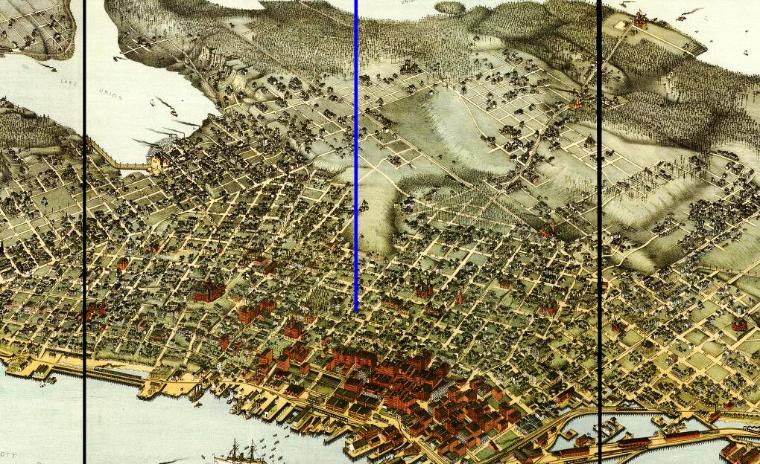 Churches of Christ & Christian Churches in the Pacific Northwest KING COUNTY, WASHINGTON |
 by Charles Dailey College index |
Seattle 1st Seattle -- University Panorama of Seattle showing Church
Next Chapter . . . Pioneer Menu . . . Search - - Oldest presented first.
Seattle -- First Church Map
The origin of the Church of Christ in Seattle are difficult to pinpoint and two of them are intertwined. Our most complete source is Washington-Northern Idaho Disciples by Orval Peterson. He says,
In September, 1882, a few members of the Christian church or the Disciples of Christ met at the home of Henry H. McDonald to consider organizing a church. The meeting resulted in the renting of a little schoolhouse on Spring Street, which was owned and used by the Episcopalians for a private school. Here a Bible school and Communion services were held regularly.On October 24, 1883, the church was organized with thirteen charter members. S. C. Espy preached once a month to the struggling congregation, which in time moved to the Y. M. C. A. Hall, then to a room on the second floor in a frame building on the southwest corner of First Avenue and Madison Street.
The report of Rufus H. Moss, writing from Seattle in 1890 probably fits in this time frame:
The First Church of Christ now meets regularly in the Young Naturalist Hall, University grounds, Seattle. My residence is 324 Olympic Ave.Mr. Moss had been in Seattle at least three years when he filed this report.
It seems that Rufus Moss had a church building built next to his residence because he reported in 1892:
The Olympic Avenue Church of Christ dedicated their new building on last Sunday. . . . Our location is at 314 Olympic Avenue.Mr. Peterson continues about what we think is another congregation:A short time later Samuel Denney, a charter member, donated a lot on Seneca Street between Third and Fourth avenues, where the first church house was erected. Early ministers were Bruce Wolverton, H. D. Holman, Rufus Moss, J. S. McCallum, R. E. Dunlap, and J. N. Smith.
(The exact location can be seen on our bird's eye view of Seattle.)
During this period a revival was held by S. M. Martin and a Mr. Eastman in a Sunday school room in the basement of the Plymouth Congregational Church. The little building on Seneca Street could not accommodate the crowd.
There were 400 additions to the church, after which Ranke Hall on Pike Street was rented. This proved to be an unsatisfactory arrangement, and a few months later the congregation returned to the little church building on Seneca Street. However, the property on Seneca Street was sold to satisfy the debt to the United Building Society. When all debts had been paid, there remained $35 in the treasury.
The church then met at the following places in the order given: The Unitarian church on Seventh, between Union and University streets, the Methodist Protestant church, and the Swedish Baptist on Eighth Avenue and Bell. These events took place during the ministry of Mr. Smith, who was succeeded by B. H. Lingenfelter in1899.
It appears that All Pilgrims Christian Church is an outgrowth of First Christian Church.
Seattle -- University Church Link
Mr. Peterson described another congregation in Seattle:
In 1888, R. E. Dunlap was called from Deer Lodge, Montana, to hold a brief meeting in Seattle. The city was in its youth, and Mr. Dunlap saw the possibilities of a church, so he suggested to H. C. Shuey and John James, elders of the church, that they secure lots in a new addition to the city for building purposes. Upon his suggestion they secured a lot at 902 Harrison Street from D. T. Denny and another on Latona Avenue at Forty-second Northeast.This building was used first in June of 1890. J. S. McCallum preached the first sermon. He moved to Olympia in 1891. He was replaced by R. E. Dunlap who ran for Washington State governor in 1896 and 1900 as the Prohibition Party candidate.The First Christian Church used the 902 Harrison Street location and later built a parsonage at 912 Harrison Street. On Latona Avenue a chapel was built, and from the Latona Chapel, University Church developed.
We can still feel Mr. Dunlap's excitement when he reported in 1893 that "15 were added Saturday night, 30 on Sunday. One thousand, five hundred people in the Armory last night."
Mr. Peterson continues:
R. E. Dunlap became the pastor of First Church, October 1, 1891, and lived in the Harrison Street parsonage. At that time there was a small Sunday school in the Latona Chapel. Later, Mr. Dunlap was invited to preach following the Sunday school hour. Professor Reeves, the acting president of the State University, served as superintendent of the Sunday school and elder of the church.The Latona Chapel was soon outgrown, and in 1901 a frame building was erected on Tenth Avenue Northeast, now called Roosevelt Way, and East Forty-second Street. The Tenth Avenue Church had two part-time pastors, A. C. Vail and R. L. Bussabarger.
Thomas J. Shuey was called to become the first full-time pastor and began his work in December, 1906. The church had about fifty members, but during his ministry the membership increased to two hundred. He served until his death in February, 1911.
Next Chapter: Kitsap County or back to Pioneer Menu

